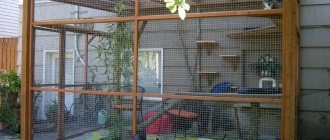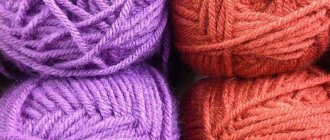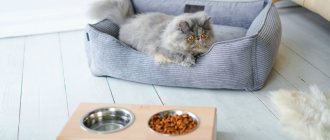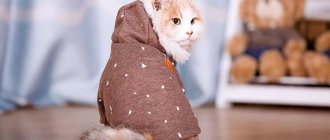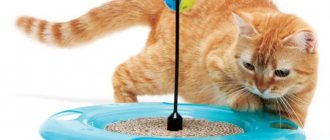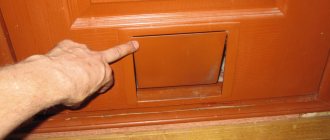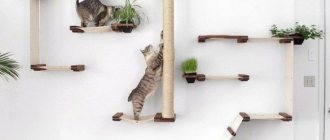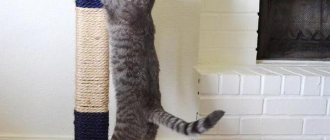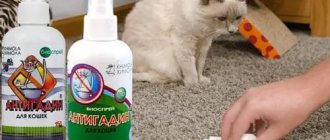How to make an Aviary for cats: for a dacha/apartment and at home, we make it with our own hands. Today, our beloved pets have become full members of the family, caring for which sometimes overwhelms us and forces us to devote more strength, attention and resources to them than to ourselves.
For this reason, more and more pet owners have begun to make adaptations that make their pets comfortable.
In this article we will pay attention to such interesting designs as enclosures for cats.
Recommendations for location and application
This is the cage of your dreams! Now we just have to figure out where to put this structure. Agree, a do-it-yourself enclosure will not always fit harmoniously into the apartment and interior. However, there are several ways to disguise it.
- To keep the dog's enclosure from being conspicuous, you can design it as a small table or cabinet. To do this, a custom-made countertop to match the interior is placed on the roof. However, this option is only suitable for enclosures with a closed top. But in general it is not recommended to close the enclosure. Therefore, it is better to come up with another way to fit it into the interior.
- It’s good if there is a corner in the apartment where the aviary will fit without problems, will not interfere and will not spoil the appearance of the room.
- Mesh enclosures without a roof can no longer be hidden so easily. But, if you manage to make it foldable, the easiest way is to remove it when not needed.
Where should the enclosure be located so that the dog feels comfortable in it?
- Choose a place where your dog can see most of the apartment.
- Avoid sunny places and drafts. The best option for placing the enclosure is one of the shaded corners of a large room.
- Under no circumstances place the cage near a battery or household appliance.
- The enclosure must be designed in such a way that it can be easily disassembled and transported or removed altogether.
And finally, it’s worth dwelling a little on the rules for using and training a dog in an enclosure. It is possible that the animal will not perceive it as something familiar the first time, so you cannot simply lock the dog in a cage.
- Start by letting the finished enclosure just sit in the room with the door open for some time. The dog must understand that he will not harm her.
- After some time, put your favorite toy or animal treat inside. It may not be right away, but the dog will still go inside for an attractive object. Be sure to praise her.
- After some time, involve the enclosure in games, that is, forcing the dog to bring a toy, periodically throw it into the cage.
- Next, training moves to a more complex level - the dog is taken into a crate and, praising it and treating it with treats, is kept in it. When the animal sits quietly in an open structure for more than 5 minutes, close the door briefly. When the dog is released again, it must be praised and treated.
Dog Door Ideas
The so-called dog or cat door (damper) is a good idea for a dacha, especially if the area is securely fenced and “strangers” will not enter the yard (and therefore the house). You can cut a small entrance in a street door yourself, but the “store” option will be much more aesthetically pleasing and functional. Nowadays there is a large selection of dog doors with various mechanisms that allow you to keep the room warm and limit the entry and exit of your pet.
The door for the animal can also be an interior door, which solves, for example, the problem when the tray is in the bathroom, because it is impossible to constantly keep the door to this room open.
Your efforts will be rewarded, because the care shown will be returned with the love and devotion of your four-legged friend.
We invite you to familiarize yourself with: Evening primrose Missourian golden
The so-called dog or cat door (damper) is a good idea for a dacha, especially if the area is securely fenced and “strangers” will not enter the yard (and therefore the house). You can cut a small entrance in a street door yourself, but the “store” option will be much more aesthetically pleasing and functional. Nowadays there is a large selection of dog doors with various mechanisms that allow you to keep the room warm and limit the entry and exit of your pet.
How to do it yourself
We will advise you on how to make a fence for a cat in your country house or on the site of a country house with your own hands. First you need to decide on the size and location. The minimum dimensions of such a pen for one cat should be 2x3 meters. We will make the enclosure from metal pipes with a diameter of 1 inch. A fine mesh netting is suitable for walls.
Design requirements
Such an enclosure must comply with all sanitary standards. Even with the smallest dimensions, it must provide space for a toilet tray, a container for food and fresh water. Installing a small house for cats to rest is encouraged. You can equip the interior space with a playground with stairs and multi-tiered shelves, toys tied to them, numerous labyrinths and a place for hiding, and hammocks.
Tools and materials
What materials will be needed when making an aviary:
- metal pipe;
- chain-link mesh, wire to strengthen it;
- wooden beam;
- slate, slate nails;
- self-tapping screws;
- cement, sand, crushed stone.
Tools:
- shovel;
- welding machine;
- drill;
- screwdriver;
- plumb line
Step-by-step instruction
- Mark the dimensions of the enclosure on the selected area, according to the chosen plan, and dig holes around the perimeter at a distance of 1-1.5 meters for installing posts - metal pipes. The length is selected taking into account the roof slope. Provide space for an entrance gate.
- Insert pre-cut posts of a certain length into the holes, strengthen them vertically with crushed stone and concrete.
- We weld the same pipes onto the upper parts of the posts around the perimeter. The roof frame is ready.
- We install the mesh using wire and welding.
- We attach a wooden beam to the upper frame with self-tapping screws.
- All that remains is to lay the slate, securing it securely with slate nails.
- We make a gate separately and hang it on one of the posts using welded hinges, not forgetting about its secure fixation (latch).
- The design of the floor can be different, in our case it is lawn grass. Other options: pea gravel, poured concrete, paving slabs, boardwalks, untreated natural stone walkways.
We made an enclosure using mesh for the walls. We offer another option - to build a similar enclosure next to the country house. Then the wall of the house with the window will simultaneously serve as one of the walls of the enclosure. The animal will have an unhindered opportunity to enter and exit home through the window.
Posting rules
When placing an enclosure in an open space, certain rules should be followed:
- the cage should be located in the shade;
- minimal exposure to wind should be provided;
- locate the structure on a hill to prevent flooding;
- placement preferably in a quiet, secluded corner of the garden.
We hope that our tips will help in caring for your pet.
| Unfortunately, ready-made enclosures for cats are not sold in Russia (if this is not the case, we will be glad to have a link to the store). Only cages of different sizes are available for sale, as well as enclosures for dogs. A cage is not suitable for walking a cat in the summer - sitting in it is torture for a cat, because any cage is still too small. The enclosure for dogs is suitable in size, but, as a rule, such enclosures use a mesh with too large cells - a cat may escape from such an enclosure. You can, of course, buy a dog enclosure and cover it with a more suitable mesh, but it will be quite expensive. Therefore, let’s consider the question of how to make an enclosure for a cat with your own hands. First, we need to purchase materials. Namely:
|
Step-by-step instructions for soft houses
You don't need much for a cat house. The main thing is to comply with the basic requirements of the “client”:
Cat wigwam
A wigwam for a cat is the simplest house. It is enough for the animal to sleep there, isolated from the household.
For it you will need:
To make a soft house for a cat with your own hands, simply follow the instructions:
1. In one of the triangles you need to cut a circle with a diameter of 20 centimeters. This will be the entrance for the cat. Here is a cardboard pattern of a cat house.
2. All “walls and floors” must be covered with fabric. A layer of foam rubber must be added to the inside of the floor.
3. All that remains is to fold the cat’s house and sew it with thread.
"High-rise"
A very interesting bed that many cats adore. There is no house here, as such. It's just a set of platforms.
An ideal option if you keep several cats at once and they won’t fit in a small wigwam (and you can’t make it bigger).
To make it you will need:
In general, there is nothing complicated. Here is a diagram of a typical cat high-rise. Transfer the parameters onto the plywood and cut with an electric jigsaw.
When all the parts are cut out, you can assemble the high-rise building like a construction set. A plywood platform is attached to the end of the beam and fixed with metal corners or directly with self-tapping screws.
A piece of jute carpet is glued on top of the upholstery platform. A scratching post won't hurt if you want to keep your furniture safe. For it you will need a dowel, a beam or even a plastic pipe. It must be tightly covered with rope. You can watch the video below on how to do this.
A simple house made from a box and a T-shirt
How to make a cat house in 10 minutes? If your pet is constantly tearing up its home, there is no point in buying or making expensive mansions for it. You can quickly make him a “den” that will last for a couple of months.
For this you will need:
1. Cut off the “lid” from the box and turn it inside out. This is necessary so that the design does not break through the fabric. However, if design is not important to you, you don’t have to do this.
2. Pull the T-shirt onto the box so that the neck line up with the hole in the box.
3. Fold the sleeves inward and secure with pins.
4. All hanging parts also need to be secured with pins.
These cat houses can be assembled with your own hands in a few minutes. If you have several pets, you can make a whole cat village.
From a hanger and a T-shirt
Another express house that can be assembled with your own hands in half an hour. For it you will need:
1. Use pliers to cut off the hooks from the hanger.
2. Line up the hanger and punch a square of cardboard. Bend the ends at 90 degrees.
3. Secure them with tape, or better yet, hot glue.
4. You should get a design like this.
5. To prevent the arcs from moving, they need to be secured with a piece of tape.
6. Now place the T-shirt on the frame.
7. Secure it with pins on the reverse side.
To make a soft house, you can sew a blanket or pillow for your cat with your own hands.
Materials and construction
The best material for a dog enclosure is structural steel. An enclosure for a shepherd can be partially made of wood (see below), but it is highly advisable to make enclosures for such smart dogs as huskies, huskies, and fox terriers completely metal - wood can be chewed.
Stages of building a wooden enclosure for a dog
However, wood is more affordable than metal and easier to work with. This is especially true if it is not possible to connect welding or power tools at any time. How to build a wooden enclosure is simple, inexpensive and suitable for almost any dog, shown in Fig. higher:
- Wood materials are impregnated twice with a water-polymer emulsion or once with silicone anti-rot impregnation.
- The ends of the support pillars made of 150x150 timber that go into the ground are additionally impregnated with bitumen mastic.
- The support pillars are concreted, pos. 1 in Fig., aligning vertically along a plumb line. The pillars need to be prepared with a margin of 10-15 cm in height, or more if the site is noticeably uneven. Installation pitch up to 1.5 m.
- After the concrete has hardened, the upper ends of the pillars are cut horizontally to the required height, using a cord and a level. Don’t rush to throw the scraps into the stove, they will come in handy.
- Pairs of pillars are connected by pairs of boards from 100x25, pos. 2.
- The floor is laid over the resulting box beams, pos. 3 (tongue and groove boards from 150x30); see also below.
- The bottom trim made of 100x100 timber, pos. 4 and 5. It is better to attach the lower harness from underneath.
- Blind holes are drilled in the bottom trim beam for the grille bars. For a German Shepherd, the rods must be no less than 10x10 or a diameter of 12 mm from ordinary steel or from 8 mm if the rods are reinforced.
- Place the bars of the grille, leaving an opening for the door, pos. 6. Installation step is 10 cm for large dogs and 5-7 cm for small ones.
- The bars of the lattice are temporarily tied with soft wire to prevent them from becoming loose.
- Prepare the bars for the top trim by drilling holes into them for the bars of the grill.
- Mount the top trim. Its beams are attached to the supporting steel corners or plywood gussets.
- Sheathing blank walls.
- They put a partition inside and arrange a winter road, if necessary.
- They make the roof (item 7) and carry out the remaining work, see below for more details.
Note: oil impregnations for wood, incl. waste motor oil can be used if the enclosure will be populated in a year. Then they build it in the spring - over the summer the light fractions of the impregnation will evaporate, and over the winter the heavy fractions will bituminize and lose their smell (they will fizzle out).
A steel enclosure is built in a similar way:
Design Features
A cat enclosure is essentially an area of a certain size, fenced with rods or mesh. It is preferable to make it spacious so that the animal has personal space. If the enclosure is equipped with everything necessary - food and water, a play area, a bed and a toilet - the pet will not feel like a “prisoner”.
Domestic cat in an enclosure built by the hands of the owner
It is important for an animal owner to learn to distinguish between enclosures with playpens and cages. All designs have a similar structure, but there are also fundamental differences
The last two designs do not have conditions for a pet to spend time comfortably.
Manufacturing
You can make an enclosure for cats at home with your own hands. Like any other building, work begins with drawing up a project. Typically, the dimensions of the installation are selected taking into account the number of animals, breed, size of the allocated area and the habits of the pet. For example, keeping a Maine Coon indoors will require much more space than keeping cats of any other breed, and a neutered cat is less active than an untreated cat - he doesn't need a large play area. But still, the recommended minimum area for each pet is 2x3 m - it is better to adhere to it.
Creating an outdoor enclosure involves several key steps.
Source
Homemade
Indoor kennels are less popular and their existence is sometimes puzzling. But you can’t do without them if:
- the dog living in the apartment has puppies;
- for a newly arrived puppy in the apartment
- other animals or children appeared in the house where there is a dog;
- there is a lap dog living in the house;
- you are planning to go outdoors with your pet.
For puppies
A dog that has just given birth needs a cozy and secluded place. She can lie down in it without worrying about the safety of her puppies. At first, the latter will also need a quiet place that separates them from the still unfamiliar, huge and scary world.
When the puppies grow up a little, the owner will already realize the need for an indoor enclosure. The fact is that growing kids are extremely active, they love to try everything, and can create a lot of destruction in the apartment.
An enclosure will also be useful when toilet training fools - many recommendations on how to do this begin with the words “Place the puppy in the enclosure.”
Pets are jealous of their owner's attention - they love him devotedly! But sometimes this jealousy can become dangerous, especially if you have a defenseless kitten, another puppy or child at home. The animal will likely become nervous and protest. To help all family members adapt to the new situation, it is worth setting up an enclosure for a while.
For small dogs
Placing a small lap dog in an enclosure on a permanent basis is an excellent solution. After a while, the dog will get used to having his own house, with food, a bedroom and a place for a toilet. This way he won’t pee in the corners and disturb the owner’s sleep, and he won’t do any mischief in your absence. For games, and upon returning home, you can always release it.
A home enclosure for a small dog doesn’t have to be super expensive: you only need 2,000 rubles maximum and 2-3 hours of free time!
A portable enclosure will be needed if you are planning a picnic with your pet. The fact is that domestic dogs in nature can become confused and either run away or fall into a stupor from fright. To save yourself and your pet’s nerves, introduce him to the world around him gradually: within the enclosure.
Maine Coon Health
The breed is not susceptible to frequent diseases, but their well-being directly depends on proper care and nutrition. An incorrectly selected diet inevitably leads to disruption of the functioning of vital organs.
Note! Representatives of the Maine Coon have a number of ailments that are inherited by them, and a predisposition to certain diseases.
Changing teeth is quite painful for an animal. This starts at four months. During this period, you can notice that the kitten is trying to chew everything that is possible. If the owner knows about this feature, he will be able to take appropriate measures to alleviate the baby’s suffering.
Despite their good health, Maine Coons are not protected from common cat diseases. Gum diseases, problems with the stomach, kidneys, liver, eye diseases, ears, inflammation of the genital organs - all this can be avoided if you properly care for your cat and carry out preventive examinations with a veterinarian.
The Maine Coon breed can sneeze, just like the average person. This can be caused by dust, strong odors, or other irritants such as wool. Prolonged sneezing becomes a reason to visit a doctor.
Important! Vaccinations for children are given according to the established schedule. The first one is placed when the baby is two months old. Before vaccination, you will need to be examined by a specialist.
Regular check-ups with a doctor
The most common ailments of this breed are:
There are also a number of genetic diseases that can manifest themselves both at a young and old age:
Design Features
A cat enclosure is essentially an area of a certain size, fenced with rods or mesh. It is preferable to make it spacious so that the animal has personal space. If the enclosure is equipped with everything necessary - food and water, a play area, a bed and a toilet - the pet will not feel like a “prisoner”.
Domestic cat in an enclosure built by the hands of the owner
It is important for an animal owner to learn to distinguish between enclosures with playpens and cages. All designs have a similar structure, but there are also fundamental differences
The last two designs do not have conditions for a pet to spend time comfortably.
Age of castration
Representatives of this breed are ready to breed from the age of 8-10 months. It is for this reason that if the owner of the animal does not plan further breeding, it is best to carry out castration or sterilization.
The need for surgery is determined by the instinct of reproduction. If this is not done, the pet will experience physical discomfort. The male begins to mark the territory by releasing a strong-smelling substance. Cats roll around on the floor, making loud sounds that are unpleasant to human hearing. In addition, this can subsequently lead to the development of various diseases.
We suggest you read: Effective flea medicine for cats
We suggest you read: Why do people keep exotic animals at home?
DIY dog enclosure
Before making a “dog house”, you need to take into account the requirements for the component elements:
- Size. The pet should be comfortable in its home, which is why the size should be selected based on the height of the animal. The height of the dog at the withers is 50 cm, so the area should be at least 6 square meters. m., the height of the dog at the withers is 65 cm, then 8 sq. m., if the dog is even taller, then the area should be at least 10 square meters. m. These parameters apply to animals that are outside around the clock. Do you take your pet for a walk every day? the size of the dog enclosure with your own hands
by 1-2 square meters. m. If you plan to place a pair of animals or a dog with a litter, then increase the indicated area by 1.5 times. A person must be placed inside the structure (for cleaning). - Make the floor with a slight slope directed towards the facade. This will prevent rainwater from stagnating in the “house”. Floor material - concrete or asphalt, make a wooden flooring (knock down boards - floor slats with a thickness of 35 mm without knots and wane) 2 by 2 m, then as a result of the concrete setting, rheumatism of dog paws will not occur. Instead of wood, use insulated crushed stone.
- Use a metal lattice to build walls, this will allow the dog to observe the overall picture of the territory and notify the owners if strangers enter the personal territory. Pre-clean the grille pipes from rust, prime them, paint them, and weld them to the frame. Not all pipes will be suitable - galvanized ones will be harmful to health, too thin ones will harm the teeth (the dog will chew them). Decorate the front part of the enclosure with a lattice, cover the remaining 3 walls with slate or boards that protect from gusts of wind.
- The door must open inward (an animal can knock out one that opens outward). Place a secure latch on the door to prevent your dog from opening it and endangering the occupants and guests of your home.
- Any roofing material is suitable for making a roof: metal tiles, slate, corrugated sheets. Do not use nails to secure the roof. Under the roofing there should be a base of boards for thermal insulation.
- There must be a dog house on the site, in which you can hide from strong gusts of wind, heavy rain, and winter frosts.
For the walls of the booth, use coniferous wood, which provides an optimal microclimate. It’s good if the building has a removable roof - you can easily clean the kennel periodically and remove your pet in case of illness. The roof should be flat with a minimum slope (the dog will be comfortable sitting on the roof and viewing the entire area). - The optimal place for construction is near the external gate, on the side of the path leading to the house.
It is very good if the structure is protected from hot sun rays and winds by branches of bushes and trees. Do not place it in the far corners - the dog will not be able to observe what is happening near the house and will bark and howl. Near the fence is not the best place; passers-by, cars, and street animals disturb the dog.
Step-by-step instructions for durable houses
Wooden house
If you decide to make a house “for centuries”, it is recommended to use wood.
This is the best material for cat permanent residence.
For it you will need:
When everything is ready, you can start making:
1. You need to glue the sides to the plywood square. Ordinary carpentry PVA, such as “Moment Joiner,” works well.
2. Make identical pentagonal walls. It is necessary to cut a passage for the cat into one of them.
3. Insert the walls into the mold and glue.
4. Now make the base of the roof. To do this, just glue in 2 crossbars made of plywood.
5. Cut small rectangles from plywood - these will be tiles. If you're lazy, you can just glue 2 squares.
6. For decoration, you can glue fake doors, as in the photo.
7. Use a drill with a brush to go over the tiles. This will create an aging effect.
8. Now it's a matter of processing. The walls need to be coated with a good layer of varnish. It's better to just paint the gate.
9. All you have to do is put the pillow inside and a great permanent home is ready.
The bedding can be soft and made of fabric material.
Shelter for homeless cats
If you decide to make a house for stray cats and kittens, fabrics will not work. You will need impermeable and warm material, and cheap one at that.
For it you will need:
First you need to prepare the input:
Then you need to connect the walls and the lid:
Now you can make a crib:
Done, you can safely move the house outside. The foam will maintain a moderate temperature inside even in severe frosts and the cats will always be warm.
How to do it yourself
We will advise you on how to make a fence for a cat in your country house or on the site of a country house with your own hands. First you need to decide on the size and location. The minimum dimensions of such a pen for one cat should be 2x3 meters. We will make the enclosure from metal pipes with a diameter of 1 inch. A fine mesh netting is suitable for walls.
Design requirements
Such an enclosure must comply with all sanitary standards. Even with the smallest dimensions, it must provide space for a toilet tray, a container for food and fresh water. Installing a small house for cats to rest is encouraged. You can equip the interior space with a playground with stairs and multi-tiered shelves, toys tied to them, numerous labyrinths and a place for hiding, and hammocks.
Step-by-step instruction
We made an enclosure using mesh for the walls. We offer another option - to build a similar enclosure next to the country house. Then the wall of the house with the window will simultaneously serve as one of the walls of the enclosure. The animal will have an unhindered opportunity to enter and exit home through the window.
Posting rules
When placing an enclosure in an open space, certain rules should be followed:
We hope that our tips will help in caring for your pet.
Variety of models
Aviary with wooden frame
With combined floor
The aviary can fit into any landscape
This might be interesting!
In the article at the following link, read about the fairytale tree houses in the forest of Noyals el Clotte.
Purpose and design features
On the territory of a private house
Using collars and leashes is an unreliable way to isolate an aggressive dog from people. The advantage of an enclosure is that here the four-legged pet has unlimited personal space. Large breeds of dogs do not belong inside the owner’s home, so your four-legged friend will comfortably spend most of his time in the enclosure. It will be well protected from adverse weather conditions (rain, wind, snow, cold and heat).
Dog handlers have established that dogs are disciplined by keeping them in separate residential buildings. The need to build an enclosure may be caused by a number of circumstances:
- the appearance of small children in the family;
- your pet has grown, and the old booth has become cramped;
- there are other animals living on the property that need protection from her attacks;
- The dog has puppies.
A spacious enclosure will become a comfortable home for your pet.
There is a misconception among some owners that by evicting their four-legged friend from their home, they will harm him.
By building an aviary on the territory of your household, you will achieve several goals at once:
- Create comfortable conditions for your pet.
- It will be safe for guests, neighbors and children to be in your yard.
- The animal is under constant supervision.
- It is more convenient to clean and care for your dog in an enclosure.
Before you start creating an enclosure, you need to determine its size, installation location and material of manufacture. When creating an enclosure design, the following (minimum) requirements must be met:
- the person who will clean the enclosure must have the necessary conditions for this;
- there must be a booth in the enclosure;
- the enclosure must be equipped with protection from rain, snow, falling leaves and branches;
- the length of one side of the enclosure must be at least two meters;
- In accordance with the height of the dog’s withers, the enclosure must have an appropriate area.
The ratio of the height of the dog’s withers and the area of the enclosure
An enclosure option for keeping one medium-sized dog
The indicated minimum sizes are intended for those dogs that, for example, are released at night to guard the territory of the entire household and do not spend most of their time in an enclosure.
Dog enclosures are divided into the following types:
- Open (enclosures that do not have a top covering).
- With partial insulation (enclosures with lattice sides).
- With an insulated block (the entire surface of the enclosure is closed).
The enclosures specified in the first two options are equipped with a booth. The third option is used for short-haired dog breeds, and in it the kennel is optional.
The roof of the enclosure is usually made of slate, soft roofing or metal profiles.
In apartment conditions
Enclosures for keeping dogs in apartment conditions are expensive. Their sizes are individual and selected in accordance with the dimensions of the pet. In order not to spend extra money, you can make this design on your own. For a small puppy, a height of 40–45 cm and an area of up to 100 square cm is sufficient. For small breeds of dogs, you can make an indoor house about 80 cm high, with an area of at least one and a half meters (if the area of the apartment allows, you can make more). There is no need to make the enclosure smaller, since your four-legged pet needs space for sleeping, playing, a toilet, and a bowl of food and water.
Enclosures for placement in apartment conditions are a structure of several metal bars or wooden fences. Such sections are connected to each other using grooves and screws. Indoor kennels are ideal for isolating a sick dog or for puppies. They have found wide application in raising aggressive dogs that damage furniture or are untrained and relieve themselves in inappropriate places.
Home enclosures made from metal sections are very popular due to their ease of assembly and cleaning. They are durable and easily fit into the interior. This design is convenient because it can be assembled in the form of a fence (for example, to block the exit from a room).
This design easily turns into a fence
An enclosure made of sections can be used as a temporary home for a dog while the owners are relaxing in the country. To do this, you need to install a booth inside the enclosure.
For small dogs there is an aviary-tent. It is convenient when you need to leave your pet at home alone without fear that he will harm himself or ruin something in the apartment. When guests arrive, small dogs are placed in such an enclosure so that they do not get in the way and no one steps on them.
Very convenient in apartment conditions
Reasons for purchasing a cell
There are many more reasons to buy a cat cage than might seem at first glance:
- going to the vet;
- trip to the country;
- relocation or flight;
- cat pregnancy;
- pet washing;
- postoperative period;
- exhibition;
- keeping in a shelter;
- catching an animal;
- disciplining the beast.
Whatever the reason for placing your pet in a confined space, it is important to remember that the cage does not limit the freedom of the pet, but ensures the safety of the predator and makes it easier to care for.
Why do you need an apartment aviary?
An enclosure is a special structure for animals, including dogs, in which they can stay for some time. Depending on its purpose, it can be made of metal, boards, and may or may not have a roof and other parts. Usually this structure is built with your own hands from metal mesh and wood.
We are used to the idea that only street dogs can live in enclosures, but this is not true. Sometimes he appears in the apartment. But if it is needed on the street to protect guests from dogs, then why is it needed at home?
An aviary or cage may be needed if:
- you got a small breed puppy and are afraid of harming him;
- you are a breeder, your dog’s puppies have already grown up and are running around the apartment;
- your pet likes to chew on things in your absence;
- guests often come to you, but the dog does not know how to behave with them;
- the dog is sick, but you also have other animals, and the enclosure will help eliminate contact between them;
- you are training your dog to go to the toilet in a diaper or in a litter tray.
By the way, the video below explains how to choose an enclosure for a dog.
Some tips from the professionals
Those craftsmen who have experience in building enclosures for cats, as a rule, offer beginners to familiarize themselves with tips that will allow them to create the right design where cats will be comfortable:
- The size of the enclosure should be proportionate to the number of pets that will be in it.
- The design of the cat enclosure can be anything that the owner likes and will be comfortable for the pet to live in.
- Materials for the enclosure must be treated with solutions against corrosion and other unpleasant consequences of environmental influences.
- An outdoor structure for cats must have a roof. It is needed not only for protection from bad weather, but also to prevent the cat from jumping over the fence.
- There should be no gaps between the wall and the floor of the enclosure through which a flexible cat can easily slip out.
- The installation of an aviary near the house is carried out in a shaded place. Regardless of the breed, prolonged exposure of a cat to scorching rays can cause health problems for the pet.
- To create comfortable conditions, an enclosure for cats must be equipped with play complexes, houses, drinkers and bowls.
- Regardless of the fact that the animals in the enclosure have limited communication with yard cats, they should be vaccinated and treated for fleas and worms in a timely manner.
- Often a few herbaceous plants or flowers are planted inside the enclosure, which can create shade and act as decoration. But it is worth remembering that there are plants that can harm the health of your pet. These include: hyacinths, ficuses, lilies, irises, hippeastrums, lilies of the valley, evergreen boxwood, jasmine gardenia and ivy. You should refrain from planting these varieties.
Materials and tools
To build an enclosure for a cat, you will need:
- mesh with fine or medium mesh;
- timber with a cross section of 50*50 mm (or more, depending on the area of the building);
- rope;
- fasteners (screws or nails);
- pegs;
- screwdriver or hammer;
- bayonet shovel;
- door hinges;
- construction level;
- roulette;
- fastening metal corner;
- door lock;
- roofing sheeting or other roofing material;
- elements of the drainage system.
Net
The main structural element is the mesh. There are several species that can be used for aviaries, but not all of them are equally suitable for this:
Shelves for cats
Sometimes the “mustachioed-striped” one doesn’t have the opportunity to frolic enough. This happens if the cat is indoor and does not go outside, and the area of the apartment is small. In this case, you can equip the wall with cute shelves, on which, when climbing, the pet will imagine itself as a real wild cat living in the forest. It’s nice that such shelves easily fit into the interior.
During the cold season, battery-powered cat shelves, which are sold in pet stores, will help. Their design is quite simple: a rigid frame with a mount (to secure it to the battery), covered with durable material, so you can make a “cat” shelf yourself.
The adaptation period - how it can be dangerous
An adult Maine Coon cat is smart, has good health and practically does not cause problems in its maintenance, but a small kitten that will have to grow up and adapt to the conditions of your apartment will need special attention. The adaptation period of a small Maine Coon will last about two months
Moreover, the very fact of moving the baby to a new home is a huge stress for the kitten. He finds himself in an unfamiliar environment, the friendliness of which he does not yet suspect, being cut off from his mother and already familiar conditions.
The adaptation period for a small Maine Coon will last about two months. Moreover, the very fact of moving the baby to a new home is a huge stress for the kitten. He finds himself in an unfamiliar environment, the friendliness of which he does not yet suspect, being cut off from his mother and already familiar conditions.
Usually, when Maine Coon kittens are transferred to a new family, they are already dewormed and vaccinated (according to the age schedule), but against the backdrop of high stress from the move, immunity failure, “breakdown” of vaccinations and other troubles can occur. To minimize the risk to the health of your Maine Coon kitten, you should follow some simple rules based on forethought.
Care of fur, claws, ears, eyes and mouth
Wool
The Maine Coon's coat is admirable, but to keep it fluffy, silky, and thick, you need to monitor its condition and take good care of it.
To do this, you will need a hairdressing arsenal of metal combs with rare, frequent and rounded teeth. During the molting period, a slicker brush may be useful.
You need to brush your cat once or twice a week, more often during shedding.
First you need to check for tangles. The risk of their appearance is especially high on the sides and legs. If there is a tangle, you need to carefully untangle it and, if impossible, cut it out.
To keep a Maine Coon you need a scratching post. If it is not enough, which rarely happens, carefully cut off the tip of the claw strictly across so as not to damage the blood vessels. Particular care must be taken with pigmented claws; they are trimmed to a minimum. The claws on the front paws should always be longer than on the hind paws.
To prevent tartar, you need to periodically brush your teeth: when feeding natural food - once a month, when feeding dry food - once every two months. The procedure requires a children's toothbrush and a special toothpaste.
Earwax may accumulate in the ears, which should be removed with a cotton pad and Vaseline as needed. You need to act very carefully because the area is sensitive and easily injured. For this reason, it is not recommended to use cotton swabs.
To remove debris from the corners of the eyes, you need to wipe with a cotton pad soaked in water.
Main varieties
All types of animal fences are divided into three main types:
Cell
The three-story Cat Playpens cage, with dimensions of 91.4 * 58.5 * 127 cm, will appeal to any pet or several cats at once, since there is enough space here. There will be drinking bowls and feeders, trays, as well as numerous equipment for animals. The cage is metal, black, with two doors. If necessary, animals can be isolated from each other. Has the following advantages:
Manege
The Triol model represents an octagonal-shaped enclosure-tent for pets. The playpen is made of synthetic environmentally friendly material (100% polyester) and has dimensions of 740*740*345 mm. Under the fabric there is a rigid metal frame, the structure is foldable. When assembled, the playpen does not take up much space. If necessary, a removable roof made of rubberized fine mesh is placed on top, which closes with a zipper. All 8 large windows around the perimeter are equipped with the same mesh. The waterproof bottom is removable and can be easily and quickly secured with adhesive tape.
The playpen is perfect for a cat before giving birth and for keeping a kitten with her. Can be used both at home and in the garden.
Manufactured in three sizes. The price, depending on the size, ranges from 2,900 to 4,470 rubles.
Aviary
Galvanized enclosure for kittens (Dog Land). Reliable coating will last for a long time. Sold in sections, which can be easily assembled into any desired shape on a summer cottage or on the site of a country house. The size of one section is 60*55 cm. The segments are fastened together with plastic ties. The price of five sections will be 1,200 rubles.
The enclosure is suitable for keeping cats and dogs in open areas.
The enclosure can also be used for kittens.
Fixture functions
What reasons lead to the need to purchase a cage for keeping a cat at home? Among them:
- prenatal period, because in the last week of pregnancy the cat is given rest, and the family may have restless babies who bother the animal;
- recent lambing, and a cat with newborn kittens would benefit from a secluded, protected and safe home;
- the postoperative period, when the patient needs to maintain peace, sterility and cleanliness;
- safety, because a separate enclosure at the dacha protects the kitten from communicating with stray animals and getting lost.
Main varieties
All types of animal fences are divided into three main types:
Cell
The three-story Cat Playpens cage, with dimensions of 91.4 * 58.5 * 127 cm, will appeal to any pet or several cats at once, since there is enough space here. There will be drinking bowls and feeders, trays, as well as numerous equipment for animals. The cage is metal, black, with two doors. If necessary, animals can be isolated from each other. Has the following advantages:
- at the bottom there is a plastic tray that is easy to clean;
- 4 wheels with lock available;
- The cage is completely dismountable and can be assembled without difficulty.
Manege
The Triol model represents an octagonal-shaped enclosure-tent for pets. The playpen is made of synthetic environmentally friendly material (100% polyester) and has dimensions of 740*740*345 mm. Under the fabric there is a rigid metal frame, the structure is foldable. When assembled, the playpen does not take up much space. If necessary, a removable roof made of rubberized fine mesh is placed on top, which closes with a zipper. All 8 large windows around the perimeter are equipped with the same mesh. The waterproof bottom is removable and can be easily and quickly secured with adhesive tape.
The playpen is perfect for a cat before giving birth and for keeping a kitten with her. Can be used both at home and in the garden.
Manufactured in three sizes. The price, depending on the size, ranges from 2,900 to 4,470 rubles.
Aviary
Galvanized enclosure for kittens (Dog Land). Reliable coating will last for a long time. Sold in sections, which can be easily assembled into any desired shape on a summer cottage or on the site of a country house. The size of one section is 60*55 cm. The segments are fastened together with plastic ties. The price of five sections will be 1,200 rubles.
The enclosure is suitable for keeping cats and dogs in open areas.
The enclosure can also be used for kittens.
cat tree
During the summer season, many cats love to climb trees: it is healthy, fun and interesting. But with the onset of cold weather, such entertainment ceases to be available, which is why pets accustomed to an active lifestyle can begin to damage furniture with their claws and climb onto shelves and curtain rods, tearing off curtains and turning everything upside down.
There is a way out - a tree for cats, which you can easily make with your own hands. Here are some ideas for a functional and beautiful cat tree.
Raising several puppies
You definitely need to buy a dog cage for your apartment if you plan to have a litter of puppies soon. Babies crawling around the room and yapping funny can seem like a real miracle, but only when they are in someone else's home. Otherwise, taking care of them is quite tedious. The growing offspring will have enough space in the enclosure to play, but the space will be limited, which makes it possible to cover it with special diapers and keep it clean.
Sometimes people decide to buy two puppies at once so that they can grow up as a pair. They will have much more fun, and they will more easily cope with the absence of their beloved owner during the working day. In this case, an enclosure for puppies will simply become a necessity, since together they will come up with many more options for active games, which means your property will be doubly at risk. At the same time, by locking them in an enclosure while you go to the store, you will come to a clean apartment and, instead of tedious cleaning, you will spend time with your pets.
Necessity or whim?
By nature, our favorite furballs, namely cats, are predators. They need a lot of space to train and play. In this case, a cat enclosure is the optimal solution. Quite often, when constructing such structures, a separate place is allocated for the playing area. Loving cat owners create entire playgrounds and even towns, without spending money on expensive materials, but using only boxes.
You can even create an unusual house by sewing it yourself. There are many options, and numerous photos from the Internet serve as proof of this. But why do you need a cat cage and is it really necessary?
Another danger for pets is stray dogs and cars. According to statistics, animals that live primarily on the street live much shorter lives. This same chance is halved given the fact that your domesticated animal is unlikely to know what to do if attacked and what damage vehicles can cause.
What does a standard design look like?
DIY enclosure for alabai: dimensions
Enclosures are divided into outdoor and indoor. If you need to separate space in an apartment or house, then simply install a partition. Residents of private and country houses are recommended to give preference to spacious structures on the streets that resemble cat estates. As a rule, they are equipped with several types of multi-level play areas.
Important! Due to the changeable climate, it is not permissible to keep a pet outdoors all the time. Such structures are only suitable as a seasonal or temporary measure.
Home enclosure for cats
Necessity or whim?
By nature, our favorite furballs, namely cats, are predators. They need a lot of space to train and play. In this case, a cat enclosure is the optimal solution. Quite often, when constructing such structures, a separate place is allocated for the playing area. Loving cat owners create entire playgrounds and even towns, without spending money on expensive materials, but using only boxes.
You can even create an unusual house by sewing it yourself. There are many options, and numerous photos from the Internet serve as proof of this. But why do you need a cat cage and is it really necessary?
Most people are accustomed to taking their animals to their dacha, where they move for the summer.
And even if no problems arise during transportation, they may begin after arrival. Usually the problem appears in the form of neighborhood cats who ardently want to meet your kitty. After meeting the village folk, your pet may be rewarded with fleas and even unplanned offspring. Another danger for pets is stray dogs and cars. According to statistics, animals that live primarily on the street live much shorter lives. This same chance is halved given the fact that your domesticated animal is unlikely to know what to do if attacked and what damage vehicles can cause.
